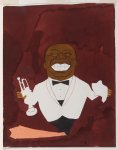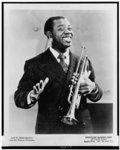Louis Armstrong is perhaps one of the most well known and respected jazz musicians of all time. As a trumpet player and vocalist, he played a large role in the development of jazz, and his music had a lasting impact on the genre. He used his trumpet as an extension of his voice, popularized scatting after forgetting the words to “Heebie Jeebies” in 1926, and developed the individual solo aspect of jazz playing.1 With his soulful playing and cheerful stage presence, he captivated audiences around the globe.His contemporaries looked up to him for his artistry, although his music-making did not go without criticism from others. Known for his wide grin and cheerful, silly stage persona, as can be seen in this caricature drawn by Makoto Wada3, this aspect of Armstrong’s playing was controversial because it evoked traces of minstrelsy in his performance.
of all time. As a trumpet player and vocalist, he played a large role in the development of jazz, and his music had a lasting impact on the genre. He used his trumpet as an extension of his voice, popularized scatting after forgetting the words to “Heebie Jeebies” in 1926, and developed the individual solo aspect of jazz playing.1 With his soulful playing and cheerful stage presence, he captivated audiences around the globe.His contemporaries looked up to him for his artistry, although his music-making did not go without criticism from others. Known for his wide grin and cheerful, silly stage persona, as can be seen in this caricature drawn by Makoto Wada3, this aspect of Armstrong’s playing was controversial because it evoked traces of minstrelsy in his performance.
The 1932 short film, Rhapsody in Black and Blue, displays these traces well. Armstrong plays jazz in a dreamland called “jazz mania” while depicting African Americans as “savage” along with other stereotypes. As a response to Armstrong’s stage presence, Miles Davis said of him, “I loved Satchmo, but I couldn’t stand all that grinning he did.”, while others accused him of being an “Uncle Tom”.2
Although Armstrong may have depicted stereotypes while catering to a white audience, through his music, he was able to celebrate his black individuality. He used the roles as opportunities to advance his career, and as he gained popularity, he used his music as a form of protest. In 1931 after being arrested, put in jail, and then bailed out so he could perform, Armstrong dedicated the song “I’ll Be Glad When You’re Dead, You Rascal, You” to the Memphis Police Force.2 He later spoke out against segregation in the audience, losing many of the audience members who came to see him.2 Although Armstrong sought to entertain, above all he was proud of his heritage, outspoken in his individuality, and paved way for many other African Americans.
https://www.loc.gov/item/98502680/.

